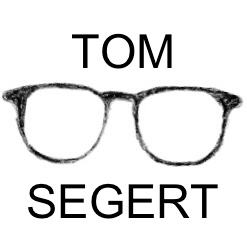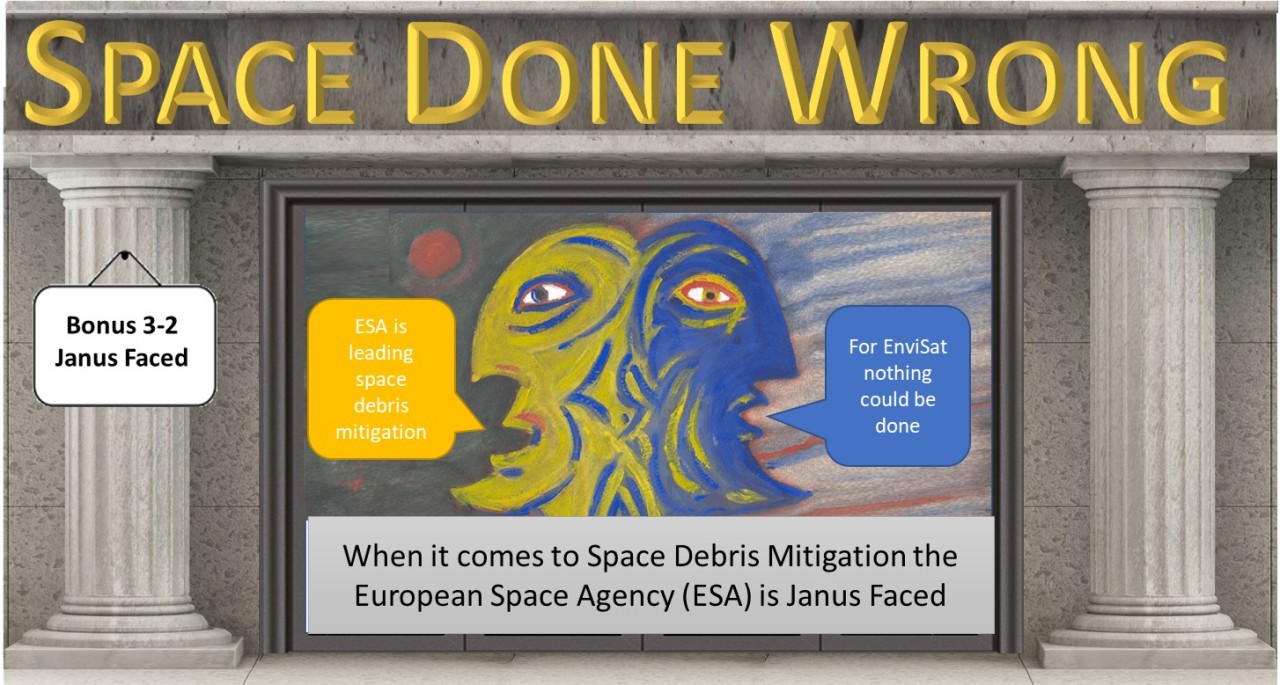While I was researching on the who is liable in case EnviSat would create a major space debris event I came across two very different faces of ESA space debris mitigation.
On the one side ESA is claiming that A) the current space debris situation is not caused by them, B) EnviSat was designed in the late 1980s long before anybody could know and C) Once in space nothing could have been done anyway. Basically saying: wasn’t me [1]!
On the other side ESA is rightfully proud to be a flag bearer of space debris mitigation since they gave themselves the policy to reduce the creation of space debris in 1989 [3]. ESA further shows its good side when it comes to space debris mitigation efforts in general. This is how they are spear heading this topic: from being a founding member to IADC in 1993, by introducing passivation of upper statges in 1997, to removing ERS2 and other large satellites from orbit in 2011. Basically saying: look we are the good guys [2]!
Since these two views, of “it wasn’t me” and “we are the good guys” are so stark in contrast I thought it would be a good point to compare them side by side. Let’s have a look!
It wasn’t me! [1]
The first face I want to talk about can best be seen in an article [1] that was published in 2012 as a reaction to a space debris session where EnviSat became a topic since it had recently stopped functioning.
When EnviSat went dark, somebody at ESA probably said: “FUCK, we are screwed”
I guess somebody at ESA shouted really loud – “FUCK – we are screwed” – at least that is what I imagine considering the deceptive nature and language that this article is written in. In the following we will look at all key arguments.
1) Envisat design predates space debris discussions

I find this section very misleading. First, the Envisat System CDR (end of design phase) was in 1997 [4]. In my eyes it is therefore not justified to write that EnviSat was “planned and designed from 1987 to 1990”. One must wonder why this was done. To me it becomes more apparent when you consider that 1997 was the time when ESA already took measures to passivate Ariane upper stages [2]. Therefore, space debris mitigation measures were already functionally implemented at ESA and not only on the discussion stage.

Secondly, ESA itself submitted the space debris guidelines to UN in 2004. Meaning they should not use the argument that UN has only established these rules in 2007 when ESA themselves published their own several years prior [6]. In addition ESA writes in their own rules that they are the result of refining the recommendations of the IADC published in 2002 [7]. Please also take note that the IADC (inter agency space debris mitigation coordination committee) was founded in 1993 and ESA is one of their founding members [12],[13].
By the time EnviSat was in the design stage not only discussed but also implemented space debris mitigation.
I think it is therefore fair to say that in the time that EnviSat was designed ESA was not only taking the lead in discussing space debris mitigation rules but was also actively implementing them. Why this was not done for EnviSat, too is unclear to me.
2) The Space Debris was not an issue at EnviSat launch

I have two observations to make: first, when faced with a major problem it seems that ESA considers finger pointing a viable strategy to distract from own responsibility. Secondly, to suggest Space debris got only a problem after the Chinese anti satellite test and the Cosmos/Iridium collision is also objective wrong in my eyes.

You may notice that if you project linear the growth of space debris before the Chinese Anti Satellite test and the Iridium/Cosmos collision then you see that the level that ESA considers critical (reached after those two events) would have been reached in 2034 [8]. Yes this is a significant acceleration but but I would argue that 27 years is much earlier than the 150+ years that EnviSat will stay in orbit without a dedicated de-orbit maneuver. I would argue that ESA should have been aware of this issue since are a founding member of IADC [13].
3) De-Orbit in 25 years was never an option for Envisat

I think I was able to show in my last article (Case Study: EnviSat) that this is not true.
Also did you know that ERS-2 which to follow ESA’s own argument – as EnviSat predecessor – double predates space debris mitigation guidelines successfully conducted deorbit maneuvers in 2011 which reduced its orbital lifetime from 200 years to 15 years? To my understanding discussion about this started in 2003 [9] and thus at the beginning of EnviSat operational phase. ESA further acknowledges that while ERS-2 was not designed for de-orbit the ample fuel – roughly half of what it was started with – allowed to do a deorbit maneuver. I think it is fair to say that not only were discussions already ongoing as we will learn later thanks to SPOT-1 the necessary maneuvers were already proven.
4) There was not enough fuel

I think this is again a misleading statement. Yes there is not enough fuel to circularize the orbit at 600km but thanks to air drag that is also not necessary (Case Study: EnviSat).
The necessary maneuvers were well documented latest since 2003. CNES who had adopted space debris mitigation rules in 1999 [5] had de-orbited Spot 1 [10] in 2003 and Spot 2 in 2009 [11] by apogee burns and as a result lowering the perigee to ~600km.
The elephant in the room
The question that really bothers me is why did ESA not apply these onto EnviSat, too? I think an answer lies in part in the observation that nobody wants to de-orbit a working satellite. That said, if that would be the only decision point then they should have left fuel to de-orbit the satellite inside the tank. However, when EnviSat died in 2013, thanks to careless use its tanks were almost empty.
As an additional data point I would like to present that, ERS-1 had a ADCS failure in 2000 and consequently could not be de-orbited anymore. ERS-2 on the other hand was de-orbited after the second (& last) payload data recorder failed in 2003. ESA briefly discussed whether to already de-orbit the spacecraft in 2003 [9] but waited until 2011 until implementing it as the satellite could still transmit data while over a ground station. This seems to indicate that ESA is more likely to de-orbit a satellite once the payload has failed (or significantly reduced functionality) but the bus is still working.
In correlation I can somewhat understand why they did not de-orbit the satellite after the end of its design life however, that they used up all fuel in life extension I believe gives view onto a malpractice with EnviSat or at the very minimum is a sign of gross negligence.
We are the good guys [2]!
The second more known face of ESA is that of a champion in space debris mitigation. ESA was among the first agencies to start discussing this topic and then implementing action.
End of Life Maneuvers for ESA satellites to reduce space debris risk

- After passivation of rockets in 1997, active de-orbit was first implemented in 2011.

- It is safe to say that by now this is established procedure.

General recommendations on end of life measures
In the same document ESA gives an overview about recommended end of life activities.

ESA recommends three things for space debris mitigation: collision avoidance (1), passivation (2) and 25 year deorbit rule (3)

ESA underlines that additionally the removal of 5-10 large objects per year (!) in 800-1400km orbits needs to be started now to avoid run away scenario.
With all that it is safe to say that ESA know what was the right approach towards space debris. They nevertheless did not act on it with EnviSat.
What should be done
Dear ESA I am glad that you want to be a champion for space debris mitigation. You have shown foresight in being a founding member of IADC in 1993, passivation of Ariane Uperstages from 1997, de-orbiting of large satellites from 2011. You are a model for us all.
There is just this “little” thing called EnviSat which is out of character. My recommendation is to again lead by example. You could do that and start by contributing to the removal of 5 large objects annually. What could be better first step than to help to de-orbit EnviSat? Maybe in the spirit of cost effectiveness – instead of trying to do the task yourself – you could organize a competition for industry to come up with ideas if you pay for the missions that remove your own past mistakes this could both encourage others to follow as also be a building block towards a sustainable business of active space debris removal.
How can you help:
This text is part of a series of articles in which the author sets the framework to start a discussion about the wrongs of the space industry. If you have experienced similar things, leave a comment. Other views and opinions are very welcome, too, as they may present a way forward. Please be kind to each other.
Disclaimer
The author’s views are his own do not represent the views of Berlin Space Technologies.
Sources
[1] It wasn’t me – ESA on Envisat and Space debris
[2] We are the good guys – ESA on space debris
[3] 20 years of space debris mitigation in Europe – Proceedings of the Fourth European Conference on Space Debris (2005)
[4] EnviSat System PDR – EnviSat-1 Mission and System Summary page 78
[6] ESA code of conduct for space debris mitigation
[7] Interagency Space Debris Mitigation Guidelines
[8] UNOOSA on space debris
[9] ESA ERS-2 de-orbit strategy (2011)
[10] CNES SPOT-2 de-orbit strategy (2009)
[11] CNES SPOT-1 de-orbit strategy (2003)


Leave a Reply